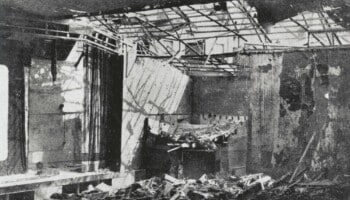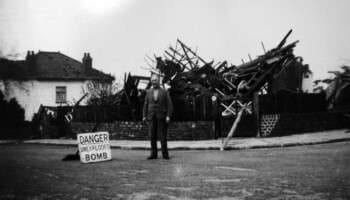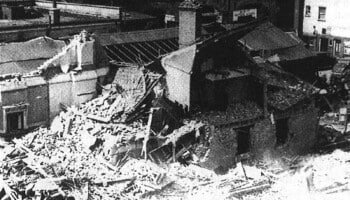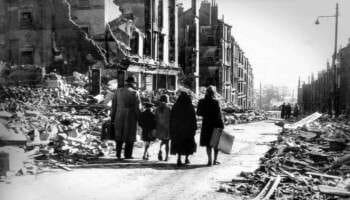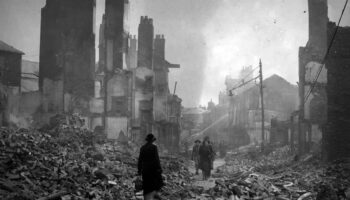Home » Resources » UXO City Guides »
UXO City Guide
Home Office Bombing Statistics for Manchester
Record of German Ordnance dropped on the County Borough of Manchester
High Explosive Bombs (All types)
712
Parachute Mines
18
Oil Bombs
7
Phosphorus Bombs
0
Fire Pots
0
Pilotless Aircraft (V-1)
1
Long-range Rocket Bombs (V-2)
0
Weapons Total
738
Area Acreage
27,255
Number of items per 1,000 acres
27.1
Why was Manchester targeted and bombed in WWII?
The city of Manchester, located in the historic county of Lancashire, was bombed repeatedly by the Luftwaffe during WWII, primarily due to its many prominent industrial targets. Manchester was not targeted with the same intensity and frequency as other major British cities such as Liverpool, Coventry and Birmingham, however it was still subject to several major raids.
Some of the key targets for the Luftwaffe were the Manchester/Salford Docks, crucial for transporting cargo and passengers to and from North America1. Additionally, Manchester’s railway infrastructure which included Manchester Central Station was also a designated target, as were its gas works, oil refinery, collieries and the Manchester Ship Canal.
Wartime targeting systems tended to be inaccurate and consequently neighbouring areas would often sustain collateral bombing. Manchester was protected by a number of barrage balloons which forced aircraft to approach their targets at higher altitudes, thereby further reducing bomb accuracy.
The Salford Docks are highlighted on the Luftwaffe target photograph below.
Home Office Bombing Statistics for Manchester
Details obtained from the official Home Office bombing statistics, indicate the quantity and type of bombs that fell on the County Borough of Manchester during WWII (excluding incendiary bombs).
A total of 738 bombs fell on Manchester, equating to an average of 27 items of recorded ordnance per 1,000 acres.
Major bombing raids on Manchester
After the surrender of France on 20th June 1940, the first bomb in the Manchester area struck Salford on the 29th July, falling between Trafford Road and Ordsall Lane2. At first, bombing raids took place during daylight hours. However, in October 1940, the Luftwaffe switched its methods to night attacks.While the Manchester-area endured a number of bombing raids throughout the autumn of 1940, the most devastating attack took place in the days immediately preceding Christmas which became known as the ‘Christmas Blitz’.
The Christmas Blitz
From 22—24 December, the Luftwaffe executed an aerial assault over the course of two, consecutive evenings, in an effort to maximize both the damage and disruption to their targets. Nearly 450 bombers raided Manchester, dropping 467 tons of high explosives and many thousands of incendiaries. Many of the city’s firefighters and their equipment were still at Liverpool where they had been sent as reinforcements the previous evening. Consequently, 400 fires erupted, 2,000 people were injured, and more than 700 died3.
Many major buildings were destroyed: the Free Trade Hall, Cross Street Chapel, the Corn Exchange and Smithfield Market were all badly damaged4. There was an uncontainable fire across the clothing and cotton goods warehouse district of Portland Street, George Street and Piccadilly, with the inflammable textiles helping to spread the flames. Eventually the military had to be called in to dynamite some buildings to create fire breaks. Parts of the area were still smouldering over a week later5.
The destruction was on an unprecedented scale, the likes of which Manchester had never experienced. Main roads into the city were impassable due to debris, craters, and unexploded bombs.
The image below is an extract of a Manchester bomb map from the University of Manchester Library. Originally used by the City Architect’s Department, the maps show fire bombs as red dots, high explosives as blue dots and line mines as green dots. Red shaded buildings represent demolished buildings while pink shaded buildings were damaged but still standing.
Can UXO still pose a risk to construction projects in Manchester?
The primary potential risk from UXO in Manchester is from items of German air-delivered ordnance which failed to function as designed. Approximately 10% of munitions deployed during WWII failed to detonate, and whilst efforts were made during, and after the war to locate and make UXBs safe, not all items were discovered. This is evidenced by the regular, on-going discoveries of UXO during construction-related intrusive ground works across the UK – not just in Manchester.
Manchester did not contain many military-related facilities or installations, so it is not common to encounter contamination from British explosive ordnance. However, items such as anti-aircraft projectiles and weaponry associated with wartime defence and the Home Guard do occasionally come to light during construction projects in certain areas of the city. Certain locations pose a much more significant risk such as the site of the former Royal Ordnance Factory in Patricroft, Salford.
I am about to start a project in Manchester, what should I do?
Developers and ground workers should consider this potential before intrusive works are planned, through either a Preliminary UXO Risk Assessment or Detailed UXO Risk Assessment. This is the first stage in our UXO risk mitigation strategy and should be undertaken as early in a project lifecycle as possible in accordance with CIRIA C681 guidelines.
It is important that where a viable risk is identified, it is effectively and appropriately mitigated to reduce the risk to as low as reasonably practicable (ALARP). However, it is equally important that UXO risk mitigation measures are not implemented when they are not needed.
While there is certainly potential to encounter UXO during construction projects in Manchester, it does not mean that UXO will pose a risk to all projects. Just because a site is located in Manchester does not mean there is automatically a ‘high’ risk of encountering UXO. It really does depend on the specific location of the site being developed.
A well-researched UXO Risk Assessment will take into account location specific factors – was the actual site footprint affected by bombing, what damage was sustained, what was the site used for, how much would it have been accessed, what were the ground conditions present etc.
It should also consider what has happened post-war – how much development has occurred, to what depths have excavations taken place and so on. This will allow an assessment of the likelihood that UXO could have fallen on site, gone unnoticed and potentially still remain in situ.
Sources
1http://rmhh.co.uk/mliners.html
2http://www.newmanchesterwalks.com/walks-tours/history-alive/manchester-at-war-the-christmas-blitz-1940/
3https://www.thetrailblazer.co.uk/politics/how-manchester-amp-liverpool-united-during-wwii
4http://www.newmanchesterwalks.com/walks-tours/history-alive/manchester-at-war-the-christmas-blitz-1940/
5https://www.thehistorypress.co.uk/articles/the-manchester-blitz/
Recent UXO discoveries in Manchester
Since the war, many items of UXO have been discovered across multiple cities within the UK, with Manchester no exception. See the news articles below about UXO incidents and discoveries from national and local press in Manchester.
1st Line Defence keep up-to-date with relevant and noteworthy UXO-related news stories reported across the UK, and you can browse through these articles using the buttons below.
Get UXO risk mitigation services from a partner you can trust
UXO City Guides
Got a project in Manchester? Not sure if there's a UXO risk? Need advice but not sure where to start?
If you need general advice about UXO risk mitigation in Manchester, contact us and we’ll be happy to help.
Call: +44 (0) 1992 245020 or Email: info@1stlinedefence.co.uk
Contact Us
* indicates required fields








